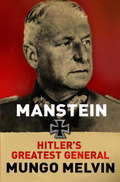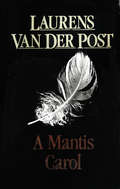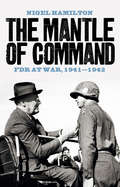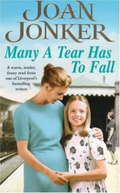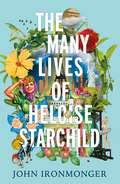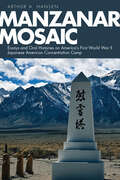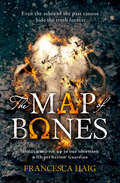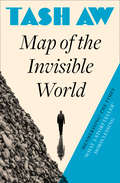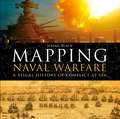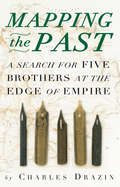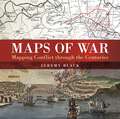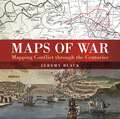- Table View
- List View
Man's Search For Meaning: The classic tribute to hope from the Holocaust
by Viktor E Frankl9 MILLION COPIES SOLD'A book to read, to cherish, to debate, and one that will ultimately keep the memories of the victims alive' John Boyne, author of The Boy in the Striped PyjamasA prominent Viennese psychiatrist before the war, Viktor Frankl was uniquely able to observe the way that both he and others in Auschwitz coped (or didn't) with the experience. He noticed that it was the men who comforted others and who gave away their last piece of bread who survived the longest - and who offered proof that everything can be taken away from us except the ability to choose our attitude in any given set of circumstances. The sort of person the concentration camp prisoner became was the result of an inner decision and not of camp influences alone. Frankl came to believe man's deepest desire is to search for meaning and purpose. This outstanding work offers us all a way to transcend suffering and find significance in the art of living.
Mansfield: A Novel (Twentieth Century Classics Ser.)
by Dr C. K. SteadSpanning three years in the life of the writer Katherine Mansfield during the First World War, this novel follows the ups and downs of her relationship with Jack Middleton Murry and her struggle to write the "new kind of fiction" which she felt the times demanded. She is restless, constantly on the move, in and out of London, to and from France, even, once, into the war zone to be with her French lover, novelist Francis Carco. For a short time, Mansfield is able to behave as though the war is merely "background", but her ardent relationship with her brother, who arrives from New Zealand to fight in France, makes detachment impossible - as does her love for Jack's Oxford friend Frederick Goodyear, also a soldier. The war's shadow remorselessly darkens all their lives, but only increases Mansfield's determination to break through as a writer. While sticking scrupulously to what is known about Mansfield's life and those of her friends (a cast that includes D. H. and Frieda Lawrence, Bertrand Russell, Dora Carrington, Lytton Strachey, Aldous Huxley, T. S. Eliot, Lady Ottoline Morrel and Virginia Woolf), this novel is extraordinary in taking the reader beyond the point of biography into the mind, emotions and sensibility of its subject. It is a sharp, subtle and appealing portrait of the person of whose work Virginia Woolf wrote: "It was the only writing I was ever jealous of."
Manstein: Hitler's Greatest General
by Major General Mungo Melvin OBEThe first proper biography of Germany's most controversial military hero.The story of the military genius Field Marshal Erich von Manstein chronicles the misguided generation of German generals in the Second World War who claimed they fought for Germany, not for Hitler and National Socialism. The polished, urbane von Manstein was no uncouth Nazi. He persuaded the British writer Liddell Hart to assist in organising his defence during his war crimes trial at Hamburg in 1949. Sentenced to 18 years' imprisonment, he was released after three and then advised the West German government in raising its new army in the 1950s.Manstein was the mastermind who created the plan for the 1940 blitzkrieg that overran France in just six weeks. He played a key role in the invasion of Russia and conquered the Crimea, but failed to rescue the doomed Sixth Army at Stalingrad, his most controversial campaign. Three months after the inevitable failure there, he inflicted a massive defeat on the Red Army at Kharkov in a brilliantly designed counter-attack: a battle that has been studied in military academies ever since.Major-General Mungo Melvin speaks good German and knows Germany well. He has been assisted by the Manstein family, has delved deeply into the military archives and studied many of Manstein's battlefields close at hand. His book is much more than a biography of an extraordinary soldier: it describes the dilemmas encountered on operations and highlights the enduring tensions between senior military commanders and their political leaders in the prosecution of strategy.In Germany today, Manstein has become a symbol of the moral corruption of the Wehrmacht, whose commanders' actions enabled Hitler to prosecute a devastating war of conquest and perpetrate the Holocaust. This book reveals the true story of Hitler and his greatest general.
A Mantis Carol
by Sir Laurens Van Der PostPresented together now for the first time, Laurens van der Post's collected writings will reveal as never before the fullness of his perceptive, wise and remarkably consistent vision. In all of them his inspiration has been that of an adventurous pioneer exploring not just the outward aspects of a turbulent and troubled world but, at a deeper level, the patterns and paradoxes of human life, the myths and dreams of the human mind, the values and cultures of different peoples, the elusive springs of our own people.
The Mantle of Command: FDR at War, 1941-1942 (Fdr At War Ser.)
by Nigel HamiltonA DRAMATIC, EYE-OPENING ACCOUNT OF HOW FDR TOOK PERSONAL CHARGE OF THE MILITARY DIRECTION OF WORLD WAR IIBased on years of archival research and interviews with the last surviving Roosevelt aides and family members, The Mantle of Command offers a radical new perspective on Franklin Delano Roosevelt's masterful - and underappreciated - role as U.S. commander in chief during the Allied war effort. After the disaster of Pearl Harbor, we see Roosevelt devising a global strategy that will defeat Hitler and the Japanese, rescue Churchill and the UK, and begin to turn the tide of war in the Allies' favour. All the while, Hamilton's account drives toward Operation Torch – the invasion of French Northwest Africa – and reveals FDR's genius for psychology and military affairs.Hamilton takes readers inside FDR's Oval Office - his personal command center - and into the meetings where he battled with Churchill about strategy and tactics and overrode the near mutinies of his own generals and secretary of war. The first part of a major trilogy, The Mantle of Command explores the life of a man whose towering importance to the war is overlooked because of his untimely death. It is an intimate, sweeping examination of a great President in history's greatest conflict.
Many a Tear has to Fall: A warm, tender, heartfelt saga of a loving Liverpool family
by Joan JonkerJust as things start to go right, heartbreak hits a family. Joan Jonker, beloved writer of the Molly and Nellie series, weaves her magic in Many a Tear Has to Fall - a heart-warming saga of a family's search for happiness. Perfect for fans of Sheila Newberry and Katie Flynn. Things are finally looking up for George and Ann Richardson. After causing years of worry, their younger daughter Tess, who had always been sickly and small, is starting to blossom into a confident, clever girl. It will be some time before she catches up with her older sister Maddy, but her family know she'll soon be just as strong. And they've just scraped together enough money to take them on their first holiday, to Wales, where the country life will be just what they need. But heartache is waiting for the family when they return to Liverpool, and many a tear will have to fall before they find the true happiness they long for... What readers are saying about Many a Tear Has to Fall: 'Joan Jonker never fails to bring a tear to your eye, a smile to your lips and a jump to your heart. I finished the book in three days and was very sad to finish the book and say "Goodbye" to a very good read. If you want a heart-warming story then this book is a must''I loved it, utterly immersed from start to finish, I found myself rooting for each of the main characters and hoping that the book would render them happy (of course it does). The only disappointment I had when it ended was that it had in fact, ended, with no continuing saga'
The Many Lives of Heloise Starchild
by John IronmongerREMEMBER ME WHEN THE COMET COMES...On the day the comet came, a girl named Heloise was born. She would live a fine life, and inherit a fortune, but would meet a cruel, untimely death. Years later, strange dreams plague Katya Nemcová, a teenager burdened with a rare and curious gift. Memories come to Katya in her dreams - images and stories from a past that isn't her own. Are these ghosts real? And what of the memory she seems to have of Heloise's treasures, two centuries old? A novel that spans the history of Europe - from revolutionary France to the world wars, the Prague Spring, post Brexit Britain, and beyond - this is the irresistible, adventurous and affectionate story of a quite extraordinary woman, her exceptionally talented ancestors and the curious memories they share.
The Many Not The Few: The Stolen History of the Battle of Britain
by Richard NorthImmortalised in Churchill's often quoted assertion that never before "was so much owed by so many to so few", the top-down narrative of the Battle of Britain has been firmly established in British legend. Britain was saved from German invasion by the gallant band of Fighter Command Pilots in their Spitfires and Hurricanes, and the public owed them their freedom. Richard North's radical re-evaluation of the Battle of Britain dismantles this mythical retelling of events. Taking a wider perspective than the much-discussed air war, North takes a fresh look at the conflict as a whole to show that the civilian experience, far from being separate and distinct, was integral to the Battle. This recovery of the people's stolen history demonstrates that Hitler's aim was not the military conquest of England, and that his unattained target was the hearts and minds of British people.
The Many Not The Few: The Stolen History of the Battle of Britain
by Richard NorthImmortalised in Churchill's often quoted assertion that never before "was so much owed by so many to so few", the top-down narrative of the Battle of Britain has been firmly established in British legend. Britain was saved from German invasion by the gallant band of Fighter Command Pilots in their Spitfires and Hurricanes, and the public owed them their freedom. Richard North's radical re-evaluation of the Battle of Britain dismantles this mythical retelling of events. Taking a wider perspective than the much-discussed air war, North takes a fresh look at the conflict as a whole to show that the civilian experience, far from being separate and distinct, was integral to the Battle. This recovery of the people's stolen history demonstrates that Hitler's aim was not the military conquest of England, and that his unattained target was the hearts and minds of British people.
The Many Not The Few: The Stolen History of the Battle of Britain
by Richard NorthImmortalized in Churchill's often quoted assertion that never before "was so much owed by so few," the top-down narrative of the Battle of Britain has been firmly established in British legend: Britain was saved from German invasion by the gallant band of Fighter Command Pilots in their Spitfires and Hurricanes, and the public owed them their freedom.Richard North's radical re-evaluation of the Battle of Britain dismantles this mythical retelling of events. Taking a wider perspective than the much-discussed air war, North takes a fresh look at the conflict as a whole to show that the civilian experience, far from being separate and distinct, was integral to the Battle. This recovery of the people's stolen history demonstrates that Hitler's aim was not the military conquest of England, and that his unattained target was the hearts and minds of British people.
Manzanar Mosaic: Essays and Oral Histories on America's First World War II Japanese American Concentration Camp (Nikkei in the Americas)
by Arthur A. HansenProviding a new mosaic-style view of Manzanar’s complex history through unedited interviews and published scholarship, Arthur A. Hansen presents a deep, longitudinal portrait of the politics and social formation of the Japanese American community before, during, and after World War II. To begin, Hansen presents two essays, the first centering on his work with Ronald Larson in the mid-1970s on the history of Doho, a Japanese and English dual-language newspaper, and the second an article with David Hacker on revisionist ethnic perspectives of the Manzanar “riot.” A second section is composed of five oral history interviews of selected camp personalities—a female Nisei journalist, a male Nisei historical documentarian, a male Kibei Communist block manager, the Caucasian wife and comrade of the block manager, and the male Kibei who was the central figure in the Manzanar Riot/Revolt—that offer powerful insight into the controversial content of the two essays that precede them. Manzanar can be understood only by being considered within the much wider context of Japanese American community formation and contestation before, during, and after World War II. A varied collection of scholarly articles and interviews, Manzanar Mosaic engages diverse voices and considers multiple perspectives to illuminate aspects of the Japanese American community, the ethnic press, the Manzanar concentration camp, and the movement for redress and reparations.
Manzikert 1071: The breaking of Byzantium (Campaign)
by Christa Hook Dr David NicolleOn 26 August 1071 a large Byzantine army under Emperor Romanus IV met the Saljuq Turk forces of Sultan Alp Arslan near the town of Manzikert. The battle ended in a decisive defeat for the Byzantine forces, with the Byzantine emperor captured and much of his fabled Varangian guard killed. This battle is seen as the primary trigger of the Crusades, and as the moment when the power of the East Roman or Byzantine Empire was irreparably broken. The Saljuq victory opened up Anatolia to Turkish-Islamic conquest, which was eventually followed by the establishment of the Ottoman state. Nevertheless the battle itself was the culmination of a Christian Byzantine offensive, intended to strengthen the eastern frontiers of the empire and re-establish Byzantine domination over Armenia and northern Mesopotamia. Turkish Saljuq victory was in no sense inevitable and might, in fact, have come as something of a surprise to those who achieved it. It was not only the battle of Manzikert that had such profound and far-reaching consequences, many of these stemmed from the debilitating Byzantine civil war which followed and was a direct consequence of the defeat.
Manzikert 1071: The breaking of Byzantium (Campaign)
by David Nicolle Christa HookOn 26 August 1071 a large Byzantine army under Emperor Romanus IV met the Saljuq Turk forces of Sultan Alp Arslan near the town of Manzikert. The battle ended in a decisive defeat for the Byzantine forces, with the Byzantine emperor captured and much of his fabled Varangian guard killed. This battle is seen as the primary trigger of the Crusades, and as the moment when the power of the East Roman or Byzantine Empire was irreparably broken. The Saljuq victory opened up Anatolia to Turkish-Islamic conquest, which was eventually followed by the establishment of the Ottoman state. Nevertheless the battle itself was the culmination of a Christian Byzantine offensive, intended to strengthen the eastern frontiers of the empire and re-establish Byzantine domination over Armenia and northern Mesopotamia. Turkish Saljuq victory was in no sense inevitable and might, in fact, have come as something of a surprise to those who achieved it. It was not only the battle of Manzikert that had such profound and far-reaching consequences, many of these stemmed from the debilitating Byzantine civil war which followed and was a direct consequence of the defeat.
Mao: The Unknown Story
by Jon Halliday Jung ChangThe most authoritative life of Mao ever written, by the bestselling author of Wild Swans, Jung Chang and her husband, historian Jon Halliday.Based on a decade of research, and on interviews with many of Mao's close circle in China who have never talked before, and with virtually everyone outside China who had significant dealings with him, this is the most authoritative life of Mao ever written. It is full of startling revelations, exploding the myth of the Long March, and showing a completely unknown Mao: he was not driven by idealism or ideology; his intimate and intricate relationship with Stalin went back to the 1920s, ultimately bringing him to power; he welcomed Japanese occupation of much of China; and he schemed, poisoned and blackmailed to get his way. After Mao conquered China in 1949, his secret goal was to dominate the world. In chasing this dream he caused the deaths of 38 million people in the greatest famine in history. In all, well over 70 million Chinese perished under Mao's rule, in peacetime. Combining meticulous history with the story-telling style of Wild Swans, this biography makes immediate Mao's roller-coaster life, as he intrigued and fought every step of the way to force through his unpopular decisions. Mao's character and the enormity of his behaviour towards his wives, mistresses and children are unveiled for the first time. This is an entirely fresh look at Mao in both content and approach. It will astonish historians and the general reader alike. ‘This a bombshell of a book’, Chris Patten, The Times‘The first great political biography of the twenty-first century’ Spectator
Maoist Insurgency Since Vietnam
by Thomas A. MarksThis is an analysis of revolutions based on the Maoist Mode. These insurgencies failed, having been successfully contained by their governments. How did the world's strongest power - America - fail where Third World governments have succeeded?
Maoist Insurgency Since Vietnam
by Thomas A. MarksThis is an analysis of revolutions based on the Maoist Mode. These insurgencies failed, having been successfully contained by their governments. How did the world's strongest power - America - fail where Third World governments have succeeded?
The Map of Bones (Fire Sermon #2)
by Francesca Haig‘Set in a vividly realised world of elite Alphas and their ‘weaker’ Omega twins, it holds a mirror up to our obsession with perfection’ Guardian The second book in Francesca Haig’s incredible Fire Sermon series.
Map of the Heart: A Novel
by Susan Wiggs#1 New York Times Bestselling Author returns with a compelling story of love and family from the present day to World War II France
Map of the Invisible World: A Novel
by Tash AwFrom the author of the internationally acclaimed, Whitbread Award-winning ‘The Harmony Silk Factory’ comes an enthralling new novel that evokes an exotic yet turbulent and often frightening world.
Mapping Naval Warfare: A visual history of conflict at sea
by Jeremy BlackNaval operations and warfare were, and remain, a key element for mapping. Maps were vital for commanders in drawing up plans of attack, and their detail and usefulness have increased over the centuries as the science of mapping has developed.This beautiful book examines stunning original maps from a series of key conflicts from the Spanish Armada, the American Wars of Independence, and the Napoleonic wars to twentieth century conflicts from the First World War to Vietnam, and explains how they were represented through mapping and how the maps produced helped naval commanders to plan their strategy.
Mapping Naval Warfare: A visual history of conflict at sea
by Jeremy BlackNaval operations and warfare were, and remain, a key element for mapping. Maps were vital for commanders in drawing up plans of attack, and their detail and usefulness have increased over the centuries as the science of mapping has developed.This beautiful book examines stunning original maps from a series of key conflicts from the Spanish Armada, the American Wars of Independence, and the Napoleonic wars to twentieth century conflicts from the First World War to Vietnam, and explains how they were represented through mapping and how the maps produced helped naval commanders to plan their strategy.
Mapping the First World War: The Great War Through Maps From 1914-1918
by Peter Chasseaud The Imperial War MuseumFollow the conflict of the World War 1 from 1914-1918 through a unique collection of historical maps, expert commentary and photographs. Published in association and including mapping from the archives of the Imperial War Museums.
Mapping the Past: A Search for Five Brothers at the Edge of Empire
by Charles Drazin‘Patsy, what are you going to be when you grow up? Well?’ 'A Royal Engineer, Daddy. A Royal Engineer!’Charles Drazin knew little about his mother's father – only that he had been a military surveyor who mapped great swathes of the British Empire. But when his mother was told that she was dying, it prompted recollections of her early life that she had never confided before: of the village in the west of Ireland where she had grown up, and of her father, whose death changed the life of an eight-year-old girl for ever.Soon afterwards her own death left her son to go through alone the relics of her life. They included a box of old photographs, a battered suitcase stamped with the initials of the grandfather he had never known, and the service records of Patrick’s brothers, who, like him, had all enlisted in the Royal Engineers as the nineteenth century became the twentieth. So began an extraordinary journey of discovery that took him from the age of Queen Victoria to the battlefields of the Western Front.Mapping the Past is the story of five brothers who, mapping the world, lived up to the Royal Engineers’ motto of Everywhere. It is the story of Ireland, and of the Empire from which it broke away. It is the story of conflict, war and its aftermath. And, most of all, it is the story of memory, endlessly carrying the past, for better or worse, into our present and future. It is an imaginative, intimate and powerful work of history, by a writer of rare power.
Maps of War: Mapping Conflict Through the Centuries
by Jeremy BlackThere is little documented mapping of conflict prior to the Renaissance period, but, from the 17th century onwards, military commanders and strategists began to document the wars in which they were involved and later, to use mapping to actually plan the progress of a conflict. Using contemporary maps, this sumptuous new volume covers the history of the mapping of war on land and shows the way in which maps provide a guide to the history of war. Content includes:The beginnings of military mapping up to 1600 including the impact of printing and the introduction of gunpowderThe seventeenth century: The focus is on maps to illustrate war, rather than as a planning tool and the chapter considers the particular significance of maps of fortifications.The eighteenth century: The growing need for maps on a world scale reflects the spread of European power and of transoceanic conflict between Europeans. This chapter focuses in particular on the American War of Independence.The nineteenth century: Key developments included contouring and the creation of military surveying. Subjects include the Napoleonic Wars and the American Civil WarThe twentieth century including extended features on the First and Second World Wars including maps showing trench warfare and aerial reconnaissance. Much of the chapter focuses on the period from 1945 to the present day including special sections on the Vietnam War and the Gulf Wars.
Maps of War: Mapping Conflict Through the Centuries
by Jeremy BlackThere is little documented mapping of conflict prior to the Renaissance period, but, from the 17th century onwards, military commanders and strategists began to document the wars in which they were involved and later, to use mapping to actually plan the progress of a conflict. Using contemporary maps, this sumptuous new volume covers the history of the mapping of war on land and shows the way in which maps provide a guide to the history of war. Content includes:The beginnings of military mapping up to 1600 including the impact of printing and the introduction of gunpowderThe seventeenth century: The focus is on maps to illustrate war, rather than as a planning tool and the chapter considers the particular significance of maps of fortifications.The eighteenth century: The growing need for maps on a world scale reflects the spread of European power and of transoceanic conflict between Europeans. This chapter focuses in particular on the American War of Independence.The nineteenth century: Key developments included contouring and the creation of military surveying. Subjects include the Napoleonic Wars and the American Civil WarThe twentieth century including extended features on the First and Second World Wars including maps showing trench warfare and aerial reconnaissance. Much of the chapter focuses on the period from 1945 to the present day including special sections on the Vietnam War and the Gulf Wars.


